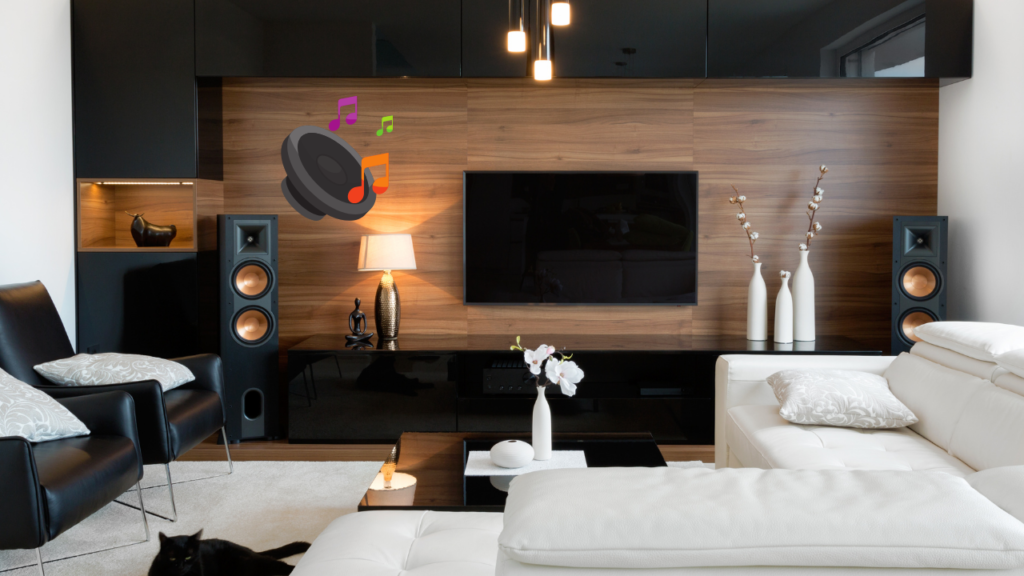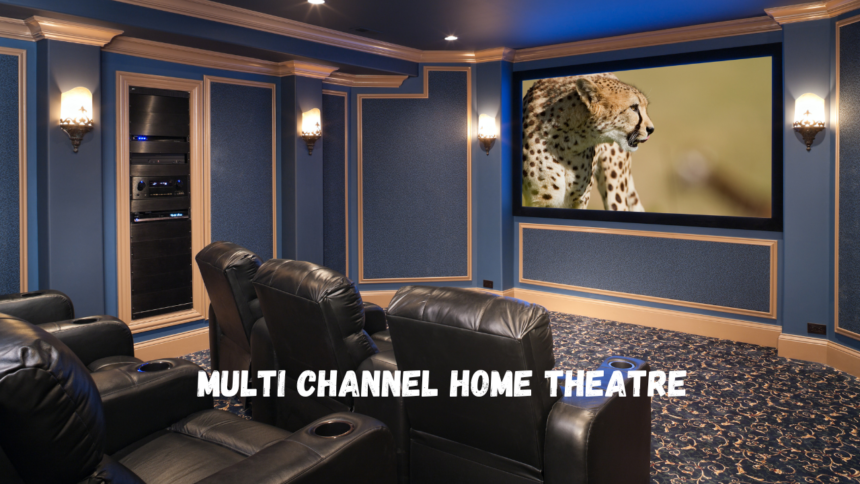Want to enjoy movies at home like in a theater? Please read our guide to set up a multi-channel home theater system! Learn about how to create Multi Channel Home Theatre. Discover the parts needed for a home theater. Understand how to arrange speakers for fantastic sound. Home theaters let you watch films with theater-quality sound at home. We explain immersive audio. Our guide has easy steps to build your Multi Channel Home Theatre. Have surround sound and feel like you’re at the movies!
Multi Channel Home Theatre System Overview
Multi Channel Home Theatre systems surround you with sound. They have speakers placed around the room, creating a captivating audio experience from every direction.
Picture watching a movie or playing a game. The sound effects seem to come from all sides. It’s like being in the middle of the action! That’s what a multi-channel setup does.
New audio techs like Dolby Atmos and DTS:X makes it even better. These formats place sounds precisely in 3D space. So the audio has more height and depth.
Love movies, gaming, or quality audio? A multi-channel system takes your entertainment to a whole new level.

The Evolution of Home Theatre Audio
Listening to sound is fun. Home theater systems bring sounds alive in a room. They make audio come from all around us.
Now, we have surround sound setups. They use Dolby Atmos tech to place sounds everywhere, making movies feel real. Also, video games seem more lifelike. We hear sounds from every direction. It’s almost like being in the game itself!
Technology keeps getting better every year. New theater systems will bring even calmer audio. We may soon have sounds that seem real. We’ll feel like we’re part of the movie or game. That would be so awesome for home entertainment!
Types of Home Theatre Systems Explained
Picking the right Multi Channel Home Theatre system can make a big difference. There are a few main kinds to choose from, each with its speaker setup and surround sound format. Let’s look at some popular options:
7.1 Surround Sound
A 7.1 system builds on the 5.1 setup. It adds two more surround speakers in the back of the room. The extra speakers make the surround sound feel more seamless and enveloping.
Dolby Atmos and DTS:X
These formats take surround sound to the next level. They add height speakers above you. A typical setup could have 5.1.2, 7.1.4, or even 9.1.6 speakers. The last number shows how many height speakers there are. The height speakers create a three-dimensional sound all around you.
Auro-3D
Auro-3D is another immersive audio format. It uses regular surround speakers plus height speakers and one overhead speaker. This unique layout aims to create a more natural, lifelike sound experience.
Picking a home theater system is about matching it to your room’s size and budget. Each kind of system has unique strengths. With the right one, you’ll get excellent audio that’s perfect for you.
Essential Components of a Home Theatre System
Creating a fantastic home theater experience needs several parts. Let’s talk about them:
AV Receiver
The AV receiver is the brain of your system. It takes audio signals from different sources and sends them to your speakers. It also decodes surround sound formats like Dolby Atmos and DTS: X.
Speakers
A multi-channel setup has front left and right, center, surround, and height speakers for immersive audio. The number and placement depend on your configuration, like 5.1, 7.1, or 5.1.2, for example.
Subwoofer
The subwoofer handles low bass sounds. It makes explosions and bass lines feel powerful and adds depth to your audio experience.
Display Device
While not for audio, you need a TV or projector, too. Pick one that matches your audio quality for the best experience.
When choosing gear, consider room size, speaker spots, and compatibility—Invest in quality for amazing immersive performance.
Setting Up Your multi channel home theatre
Setting up your Multi Channel Home Theatre is easy when you follow the proper steps. First, you need to plan where each speaker will go.
Plan Your Speaker Configuration
Look at your room size and seating layout. Decide where to place the front, center, surround, and height speakers will give you the best sound coverage.
Position Your Speakers
Put the front left and right speakers at equal distance from your seat. They should point slightly towards you. Place the center speaker above or below your TV. Surround speakers go on the sides, a bit behind you, at ear level. For immersive audio like Dolby Atmos, install height speakers above or use bouncing speakers.
Connect Your Speakers
Use good speaker wire to connect each speaker to your receiver. Make sure the positive and negative wires match up for clear sound.
Set Up Your Subwoofer
Find a spot where the subwoofer’s bass sounds even throughout the room. You may need to test a few places. Hook it up to the subwoofer output on your receiver.
Set Up Your AV Receiver
Follow the instructions that came with your AV receiver. You need to configure the settings for your speakers, including the size of each speaker, how far away they are, and how loud they should be. Many newer receivers can do this automatically. They use a microphone to measure the room and adjust the settings based on that.
Tweak and Enjoy Your Home Theater
After the initial setup:
- Take some time to make adjustments.
- Change the volume levels for the speakers.
- Try out different listening modes.
- Customize the settings to what sounds best to you.
Once you’re happy with how it’s all set up, relax and enjoy the fantastic sound of your multi-channel home theater.
Speaker Configuration and Placement
Setting up speakers is essential for getting the best sound from your home theater system. Here are some tips to help you set up your speakers properly:

Surround Speaker Placement
For 5.1 and 7.1 systems, place the surround speakers on the sides and a little behind where you sit. Put them at ear level or just above. This placement helps create sound around you, so you feel like you are in the middle of the audio.
Height Speaker Placement
If you have height speakers for Dolby Atmos or DTS:X, you have a few options. You can install speakers in the ceiling, use up-firing speakers that bounce sound off the ceiling, or mount height speakers on the wall above your front speakers. Try different placements to see what works best in your room.
Angling Your Speakers
Angle your front left and right speakers slightly towards where you sit helps create a focused sound stage and improves the stereo sound. It makes the overall audio experience better.
Every room is different, so don’t be afraid to try different speaker layouts and placements. Find the setup that gives you the most immersive audio for your space.
The Technical Side of Home Theatres: Decoding Audio Channels
It is essential to know about audio channels. This helps you get the most out of your multi-channel home theater system. Let’s talk about some standard surround sound formats and what they mean:
5.1 and 7.1 Surround Sound
In a 5.1 system, the “5” means five full-bandwidth channels. These are front left, front right, center, surround left, and surround right. The “.1” is the low-frequency effects (LFE) channel for the subwoofer. A 7.1 system has two more surround speakers at the back of the room.
Audio Formats
Formats like Dolby Atmos and DTS:X take surround sound further. They add height channels. The number of channels is “x.y.z.” “x” is the ground-level speakers. “y” is the subwoofers. “z” is the height speakers. For example, 5.1.4 has five ground-level speakers, one subwoofer, and four height speakers.
Object-Based Audio
Immersive audio formats use object-based audio. This lets sound designers place and move sounds in a three-dimensional space create a more lifelike and dynamic audio experience. Sounds can seem to come from specific places in the room.
By understanding these details about audio channels, you can better appreciate your Multi Channel Home Theatre system’s abilities. You can also make informed choices when selecting components and setting up your speakers.
Conclusion
Ultimately, “Multi Channel Home Theatre” is a guide to fantastic audio at home! It shows how home theater sound developed and teaches setting up multi-channel systems. This book helps audio fans of all levels understand speaker setup, decoding audio channels, and creating immersive audio. With this knowledge, readers can build movie-like sound in their living rooms.
By exploring Multi Channel Home Theatre benefits and tackling common issues, this guide empowers readers to craft fantastic audio for gaming, movies, and more. With info on immersive tech like Auro-3D and Dolby Atmos, plus expert tips on room layout and gear choice, readers can level up their audio experiences.
FAQs:
What is a Multi Channel Home Theatre system?
A Multi Channel Home Theatre has many speakers placed around the room, creating a surrounding sound, like at movie theaters. Advanced systems have 3D sound with something like Dolby Atmos.
What parts do I need for a Multi Channel Home Theatre system?
You need an AV receiver, multiple speakers, a subwoofer for bass, and a TV or projector. The receiver connects everything. Different speakers go in different spots to surround you with sound.
How should I place my speakers for the best sound?
Put the front speakers at equal distances from your seat. Angle them slightly towards you. Side speakers go at ear level around you. Height speakers mount above or aim up to create 3D sound.







